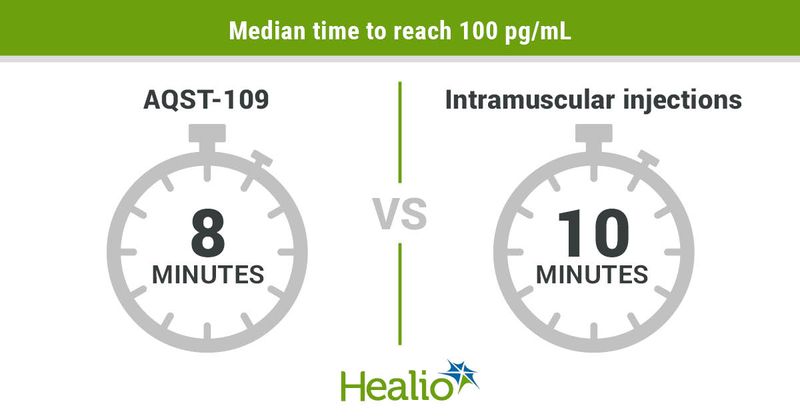Sublingually administered epinephrine continues to show promise
Click Here to Manage Email Alerts
Researchers confirmed that epinephrine can reach therapeutic plasma concentrations via sublingual administration during the second part of the ongoing EPIPHAST study conducted by Aquestive Therapeutics.
“The overall study is designed to understand product characteristics, inform regulators and communicate to health care providers about different factors that could affect epinephrine blood levels, heart rate, blood pressure and safety following administration of sublingual film compared to that following different doses of epinephrine injection, including looking at comparisons that FDA has requested,” John Oppenheimer, MD, FAAAAI, clinical professor of medicine at UMDNJ Rutgers, told Healio.

The second part of the study involved 24 healthy subjects who received 12 mg doses of Aquestive Therapeutics’ AQST-109 epinephrine oral film, which the company called the first and only orally delivered epinephrine product candidate and a potential paradigm shift in the management of severe allergies.
The participants experienced a median time to maximum concentration (Tmax) of 15 minutes with AQST-109, compared with 50 minutes for a 0.3 mg intramuscular injection dose of epinephrine.
Also, the participants had comparable areas under the curve (AUC) for the clinically relevant periods of 10, 20 and 30 minutes for AQST-109 and for the intramuscular injections, according to a press release issued by Aquestive Therapeutics.
The median time to reach 100 pg/mL, which the company said has been suggested as the threshold for the onset of hemodynamic effects, was 8 minutes for AQST-109 and 10 minutes for the intramuscular injections.
In addition, Aquestive Therapeutics said, AQST-109 demonstrated maximum concentration (Cmax) values that were consistent with the intramuscular injections and with previously reported values for approved injectable epinephrine devices such as EpiPen (Viatris).
Specifically, arithmetic mean Cmax totals were 426.1 pg/mL for AQST-109 and 396.7 for intramuscular injections, with corresponding rates of 274.3 pg/mL and 350.6 pg/mL for geometric mean Cmax totals.

“The rapid attainment of peak blood levels following sublingual film administration is notable for a product that is being developed as an anaphylaxis rescue medication, where time to clinical effect is an important consideration,” said Oppenheimer, who also is an allergist at Pulmonary and Allergy Associates NJ.
AQST-109 also produced favorable pharmacodynamic effects on systolic blood pressure, diastolic blood pressure and heart rate, the company said in the release.
“The concurrent and positive effects on heart rate and blood pressure are also favorable given the potential negative cardiovascular impact of anaphylaxis on these parameters,” Oppenheimer said.
Further, Aquestive Therapeutics noted that AQST-109 would be a suitable alternative for many patients who may not benefit from intramuscular injections due to needle phobias, delayed administration or other reasons.
“A portable, needleless delivery, fast and easy to administer rescue medication for severe allergic reactions, including anaphylaxis, is expected to have a meaningful impact on the care of patients, where the current care is encumbered by a relatively difficult to carry and administer injectable device,” Oppenheimer said.
Aquestive Therapeutics said it will commence part 3 of the study this month and expects it to conclude by the end of the second quarter of 2022.
“Part 3 of the EPIPHAST study will continue to assess additional factors that could affect epinephrine blood levels, heart rate, blood pressure and safety following administration of sublingual [epinephrin],” Oppenheimer said.
This part of the study will focus on varying administration times and use with food, again with 24 participants, to further characterize AQST-109’s pharmacokinetics and pharmacodynamics, Oppenheimer said.
“I am hopeful AQST-109 will change how patients and caregivers manage anaphylaxis,” Oppenheimer said.
For more information:
John Oppenheimer, MD, FAAAAI, can be reached at nallopp@gmail.com.


